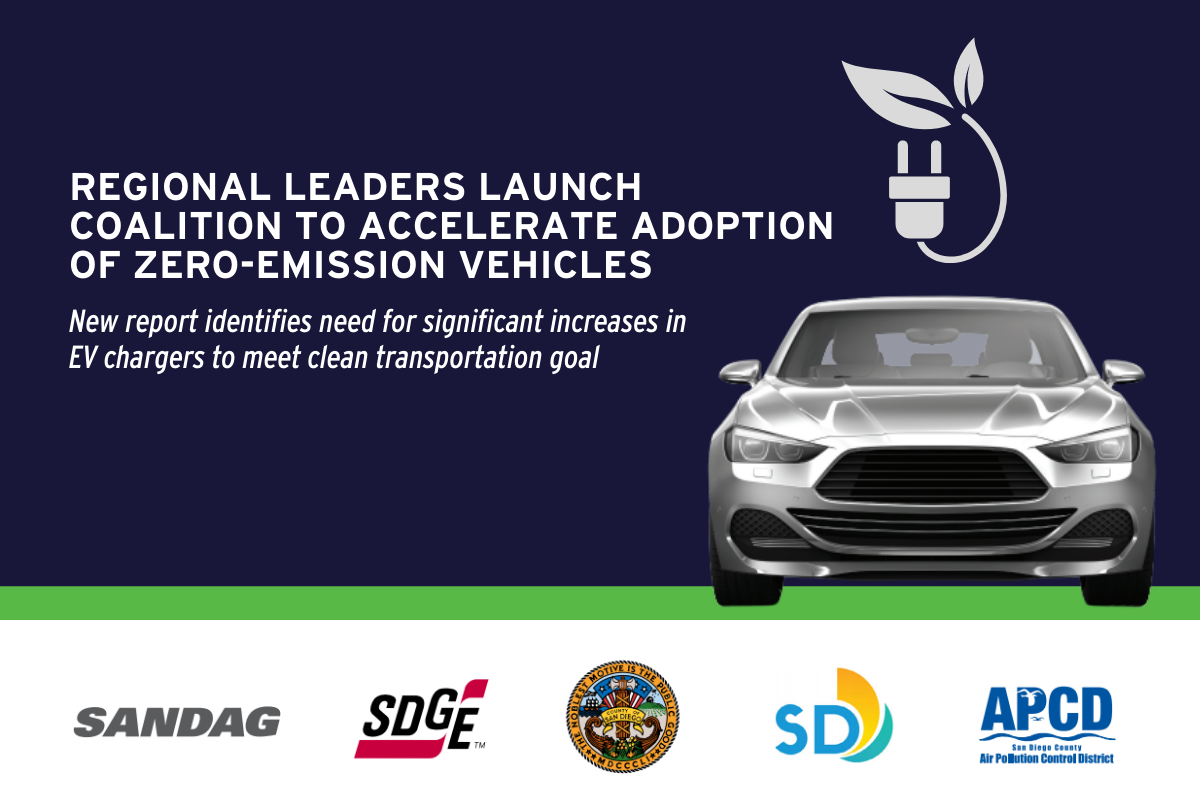Lea el comunicado de prensa en español aquí.
New report identifies need for significant increases in EV chargers to meet clean transportation goal
Today, a diverse group of local leaders representing public, private and nonprofit organizations announced the launch of Accelerate to Zero Emissions (A2Z) – a first-of-its-kind regional collaborative dedicated to curbing air pollution and climate change through clean transportation. The coalition – consisting of 13 entities, including the region’s largest cities – aims to make it easier for local residents and businesses to transition to electric vehicles (EV), plug-in hybrids and hydrogen fuel cell vehicles.
“We can’t combat the climate crisis alone – it’s collaborative partnerships like this that will help us reach our city’s climate action goals faster and deliver crucial air quality improvements for our communities,” said San Diego Mayor Todd Gloria. “This important commitment to transforming our transportation sector will create good local jobs and protect our quality of life for the next generation and beyond.”
At a press conference at the San Diego County Administration Center, A2Z leaders released the results of a newly completed gap analysis, which identifies barriers to widespread adoption of zero-emission vehicles (ZEV), particularly in underserved and marginalized communities. The report also quantifies for the first time how many EV chargers and hydrogen fueling stations are needed for the region to meet its share of California’s clean transportation goal – 8 million ZEVs on the road by 2030. The San Diego region’s share of that goal is 771,000. As of 2020, the region had about 69,000 ZEVs on the road. To keep pace with the region’s targeted level of ZEV growth, about 155,000 EV chargers and a few dozen hydrogen fueling stations are needed. As of 2020, there were 6,700 chargers in the region and one hydrogen fueling station.
“We have a long way to go to clean up the transportation sector – the largest source of greenhouse gas emissions in California and in our region and a very significant source of air pollution,” said Estela de Llanos, SDG&E’s vice president of energy procurement and sustainability. “The gaps in our fueling infrastructure for zero-emission vehicles are so large, no single entity can solve the problem on its own. Regional collaboration is critical.”
As part of their climate action plan or sustainability strategy, many local jurisdictions, agencies and companies have already adopted clean transportation goals, policies and programs on their own. SDG&E, which has pledged to reach net zero GHG emissions by 2045, has a diverse portfolio of programs to expand the regional EV charging infrastructure and has announced plans to pilot hydrogen fleet vehicles. Some local cities and agencies have recently upgraded their own fleets with electric or hybrid vehicles. Some have adopted zoning ordinances for EV parking or streamlined the permitting process for installing chargers. The gap analysis found multiple overlapping clean transportation efforts and recommends coordinating them to make a bigger impact.
Aside from SDG&E and the City of San Diego, other core members of A2Z are the County of San Diego, the county Air Pollution Control District and San Diego Association of Governments (SANDAG). Other coalition members include the cities of Carlsbad, Chula Vista, Escondido, Santee, Cleantech San Diego, Grid Alternatives, MAAC, and the University of San Diego’s Energy Policy Initiatives Center. A2Z’s mission is not just to get the San Diego region on a faster path to clean transportation. Equally important to the coalition is doing it in an equitable manner – ensuring residents of all income levels have access to zero-emission vehicles and share in their benefits. A2Z started coming together last summer amid the height of the pandemic.
“I’m proud of this coalition for its focus on climate equity and environmental justice,” said Supervisor Nora Vargas, Vice Chair of the County Board of Supervisors and Chair of the Air Pollution Control District board. “This is something we’ve been fighting for in District 1. Some of our communities are among the most impacted and are often located along heavily traveled transportation corridors. As a result, these communities suffer from higher levels of asthma and other negative impacts. Reducing transportation-related pollution will help improve public health so we can continue to build healthier and stronger communities.”
“Today is a momentous day for our region as we release the first electric vehicle infrastructure report for San Diego County,” said SANDAG Second Vice Chair and National City Mayor Alejandra Sotelo-Solis. “Collaboration among agencies like SANDAG, the County, the City of San Diego, and SDG&E is more important than ever as we work to create a faster, fairer, and cleaner transportation system through the 2021 Regional Plan.”


